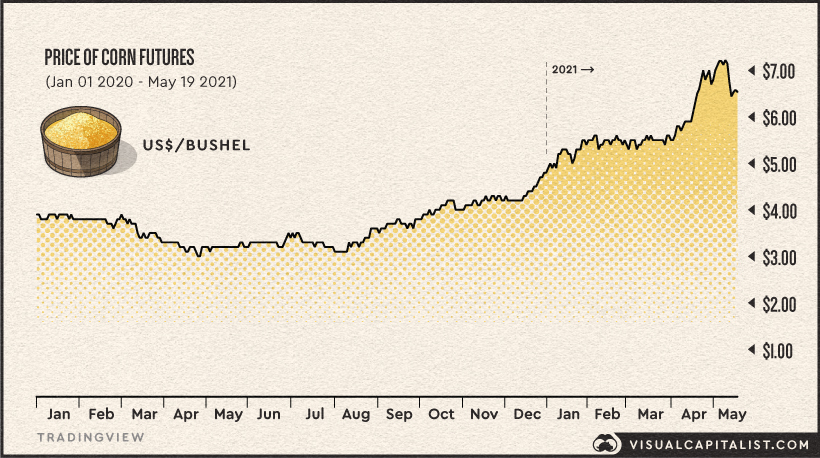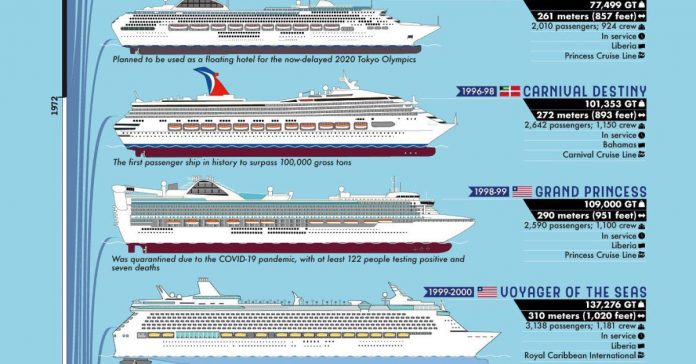Corn is the second most widely produced crop in the world and more than just a staple in our diet.
From the sweetener in our coffees to the ethanol that powers our vehicles, corn has hundreds of uses. As a result, high corn prices have a knock-on effect that can affect many supply chains and potentially even add to the cost of our weekly groceries, especially if they contain tortilla chips.
This infographic uses data from the National Corn Growers Association to break down US corn consumption by segment in 2020 and the products a bushel of corn can produce.
The Uses of Corn in the US
While corn on the cob are very popular, not all corn on the cob is cute. There are five main varieties of corn grown around the world, and each one is different in taste and use. Of these, yellow dent corn, or field corn, makes up the majority of US commercial production.
Here is a breakdown of U.S. corn consumption in 2020:
| segment | Bushels Used (Millions) | % of usage (2020) |
|---|---|---|
| Lining | 5,650 | 38.7% |
| Ethanol (fuel) | 3.875 | 26.6% |
| Exports | 2,550 | 17.5% |
| Ethanol (animal feed) | 1,075 | 7.4% |
| Sweeteners | 780 | 5.3% |
| Strength | 230 | 1.6% |
| Grain / other | 215 | 1.5% |
| Drinks / alcohol | 170 | 1.2% |
| seed | 30th | 0.2% |
| total | 14,575 | 100% |
Corn is more than important 96% the use and production of US feed grain. As a result, animal feed accounts for nearly 40% of the country’s corn consumption. This is because corn is a rich source of carbohydrates and when combined with soybean protein, it can be an effective diet for farm animals.
In the United States, federal mandates require vehicles to use a blend of gasoline and biofuels such as ethanol.94% of which is made from the starch in corn kernel. Therefore, much of the US corn goes into ethanol production.
Interestingly, the ethanol distillation creates a by-product known as the dried distillator grain, which is used as an inexpensive, protein-rich animal feed for farm animals. On average, the US ethanol industry produces around 90,000 tons of burner grains every week.
Animal feed and ethanol production together make up around 73% of US corn usage. Other uses of corn include making sweeteners, starches, cereals, and alcoholic beverages such as whiskey.
Breakdown of US Corn Exports
The US is the world’s largest producer and exporter of corn, accounting for around 36% of exports in 2020.
By 2019, the bulk of US corn exports went to Mexico, Japan, and Colombia. China wasn’t in the top 10 travel destinations, but that changed in 2020.
US corn exports to China grew exponentially between January 2020 and 2021, reaching an all-time high in December. China’s massive import appetite can be attributed to a lack of domestic deliveries due to increasing demand for feed from its recovering pig herd, which was hit by the African swine fever in 2018.
As a result, China became the third largest importer of U.S. corn in 2020 after Mexico and Brazil. Additionally, the U.S. Department of Agriculture expects China’s corn imports in 2021 to be well above 2020 levels, and most of that will come from the U.S.
The corn price boom
In addition to a drop in yields in Brazil caused by drought, rising demand from China has pushed corn prices to the highest level in eight years.

Corn prices have risen since the beginning of 2020 68% and will stand at around $ 6.50 a bushel as of May 19th.
The rise in corn prices is likely to affect multiple industries and could result in higher prices for our groceries, including cereals, taco clams, and corn syrup. Additionally, due to its key role in ethanol production, it could also drive gas prices higher.
Corn in a bushel
In a world where commodities like corn are often taken for granted, it’s important to consider how valuable they can be.
A single bushel of corn can provide 33 pounds of sweetener, 31.5 pounds of starch, or 22.4 pounds of polymer. It’s also enough to make about 3 gallons of ethanol fuel and 16 pounds of distilled dried grains for animal feed.
The use of corn goes well beyond the cob and, like other raw materials, supports many industries that make modern life possible.

